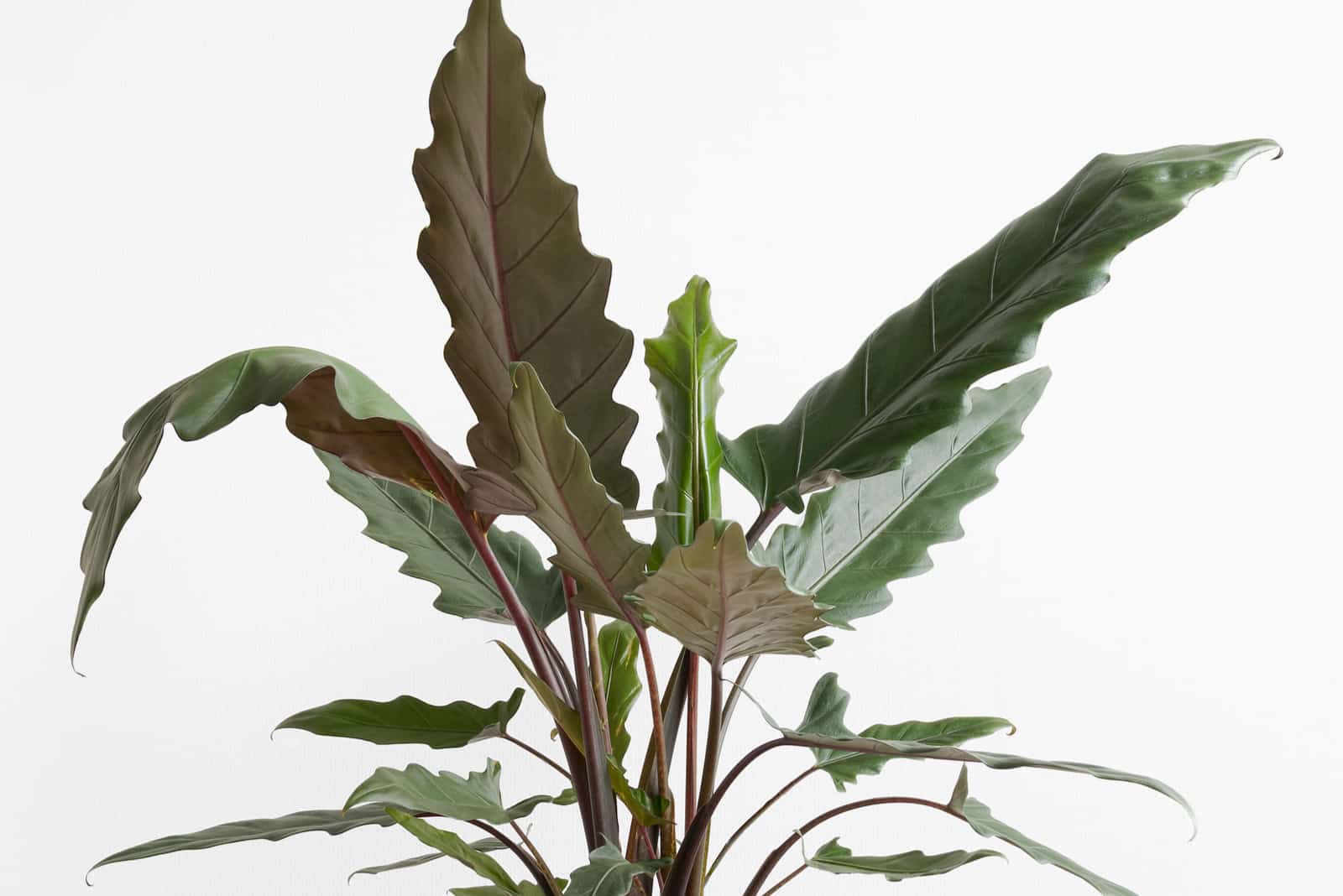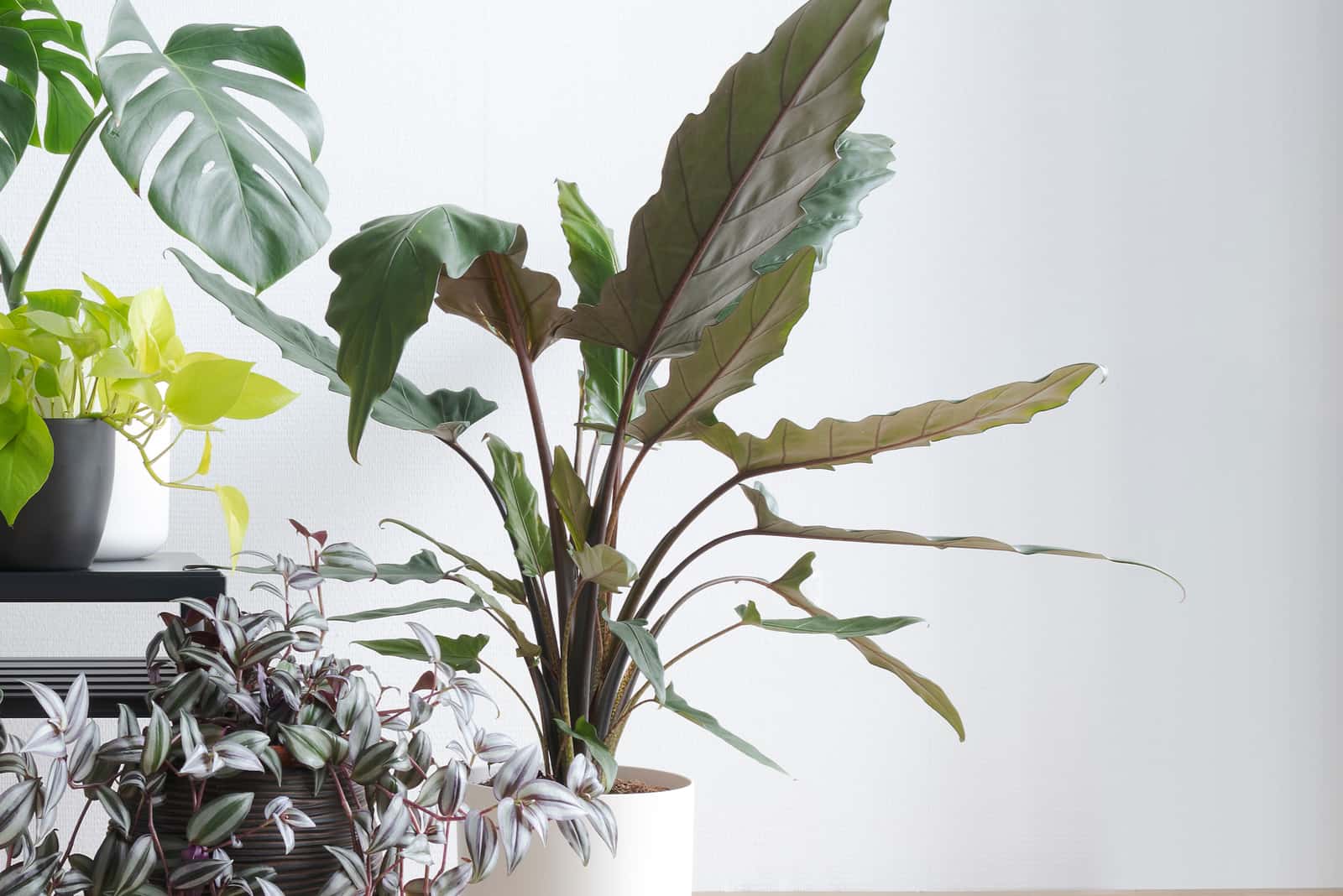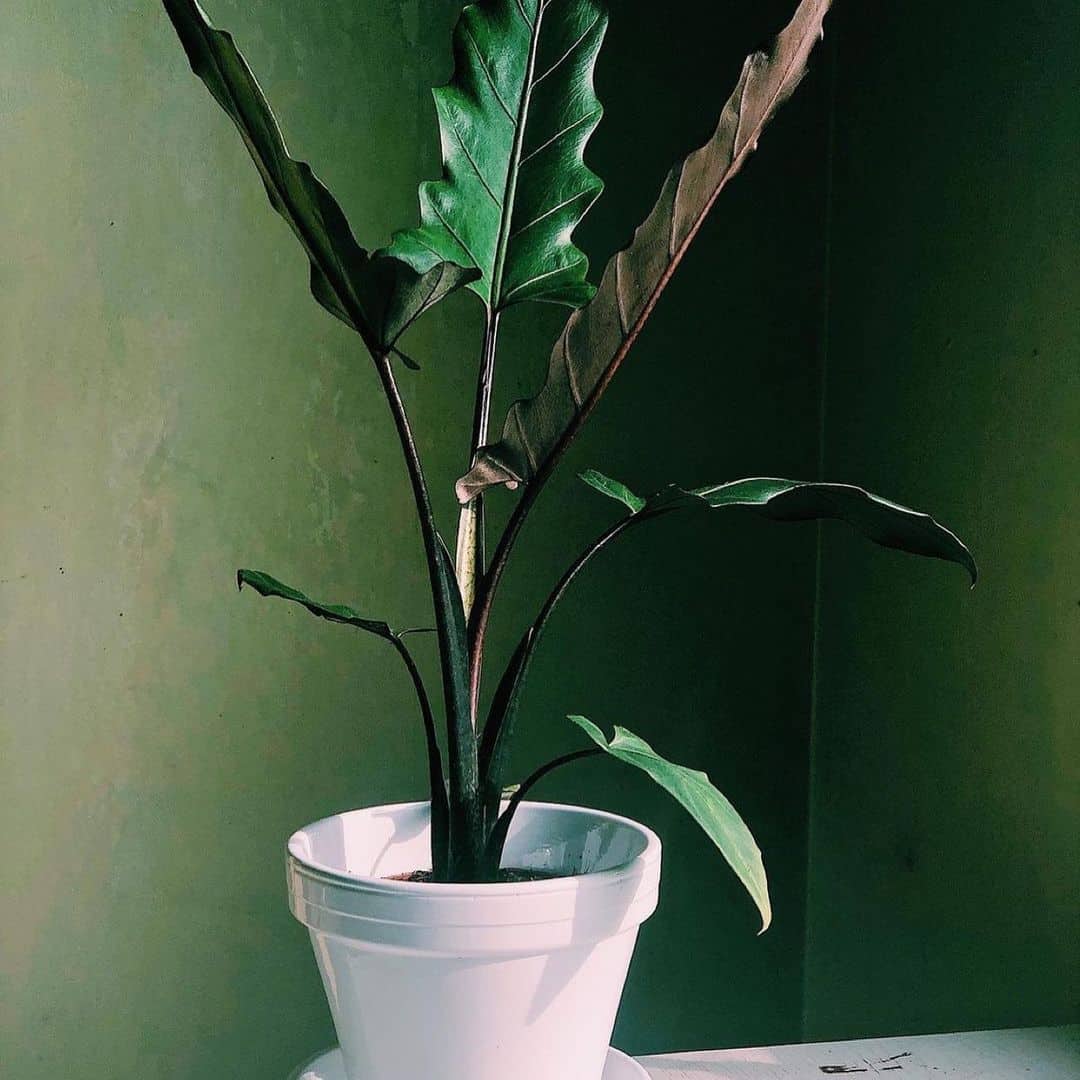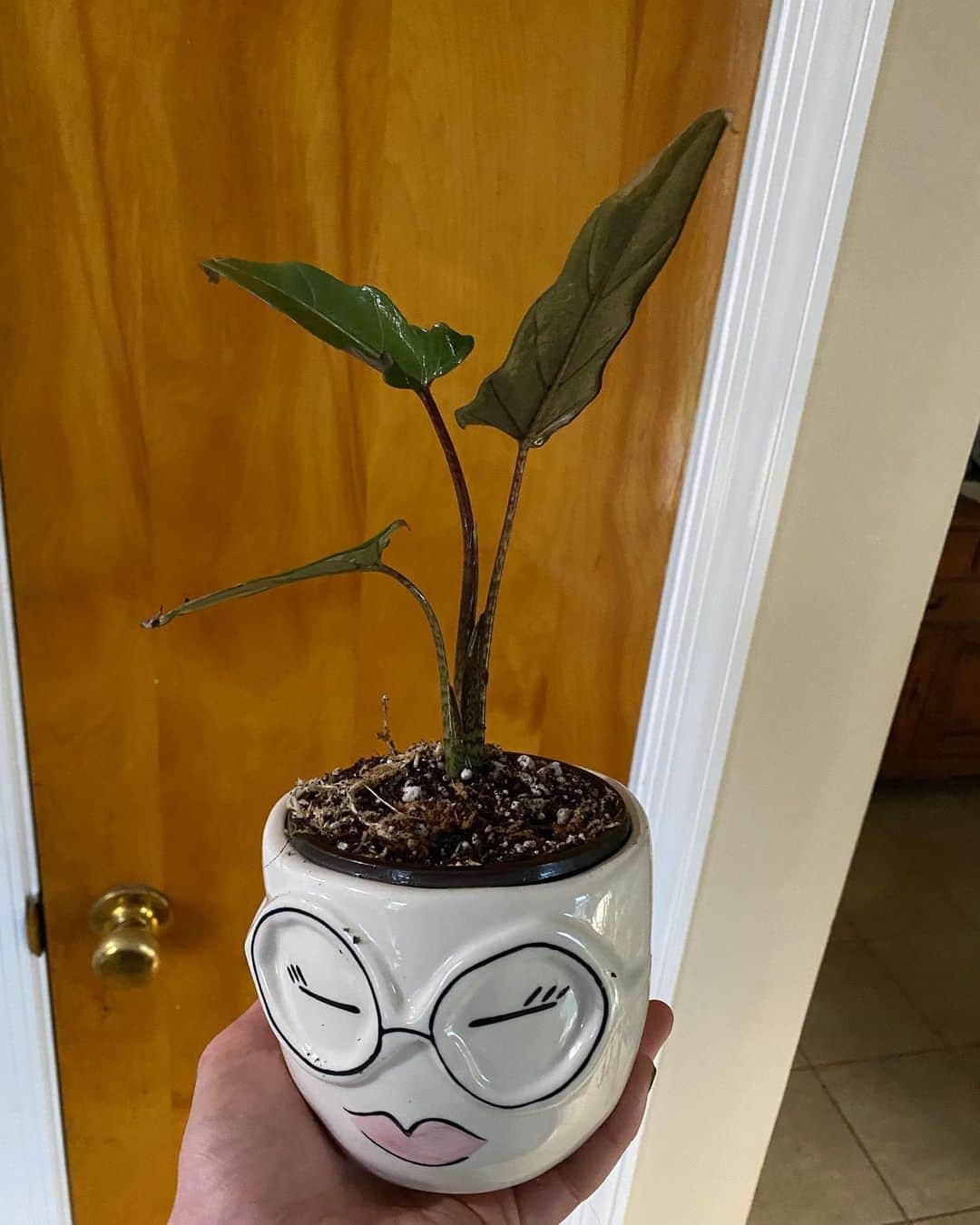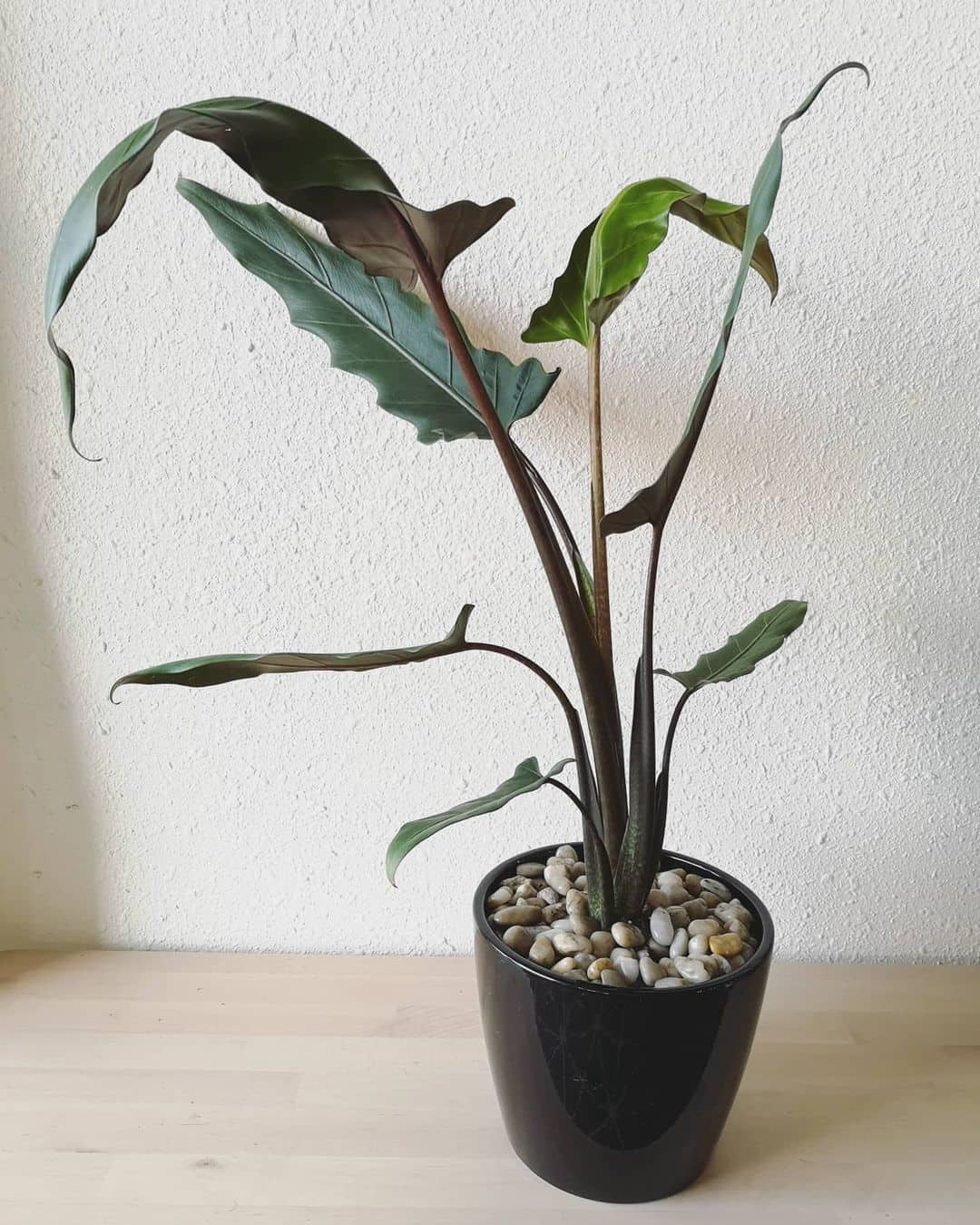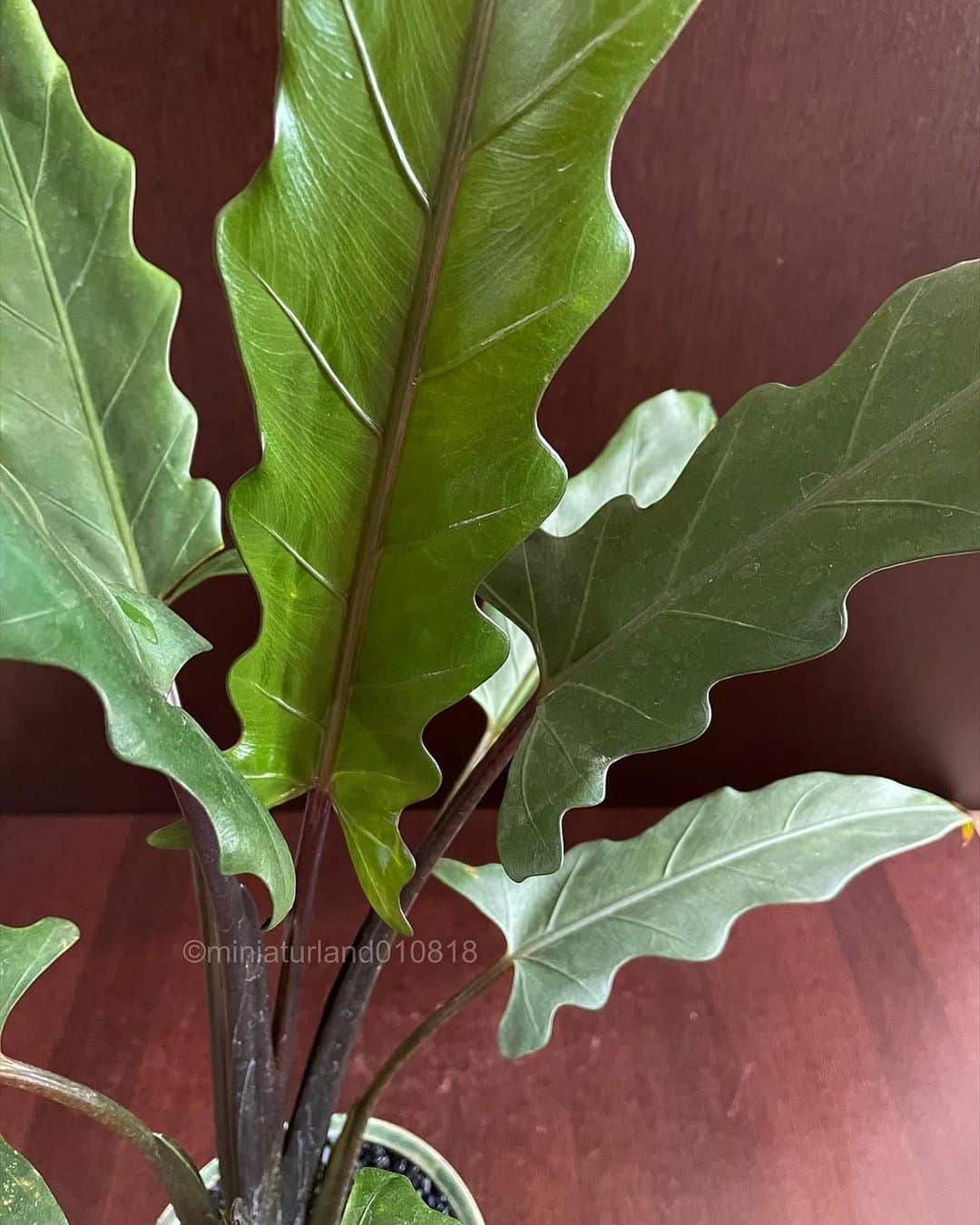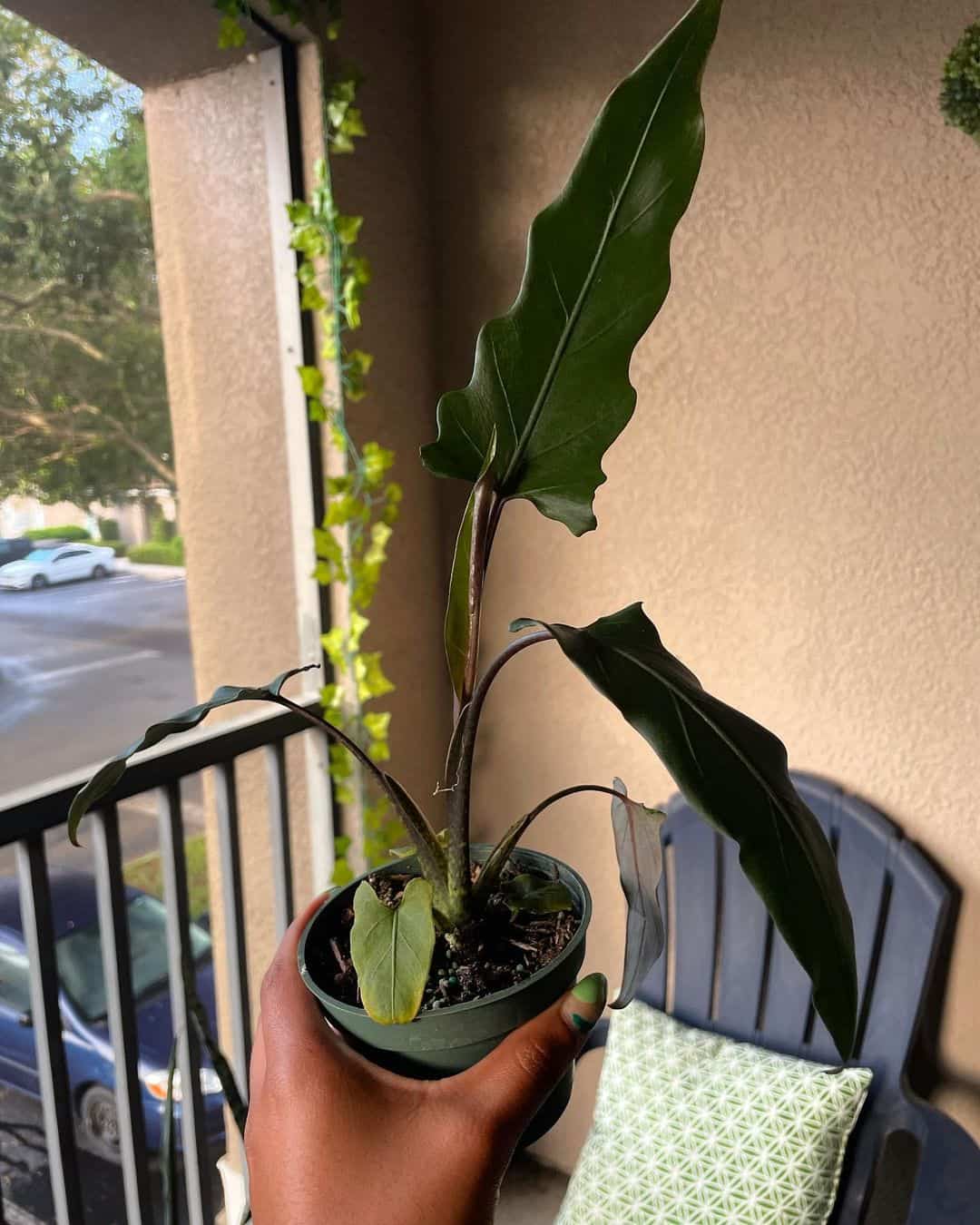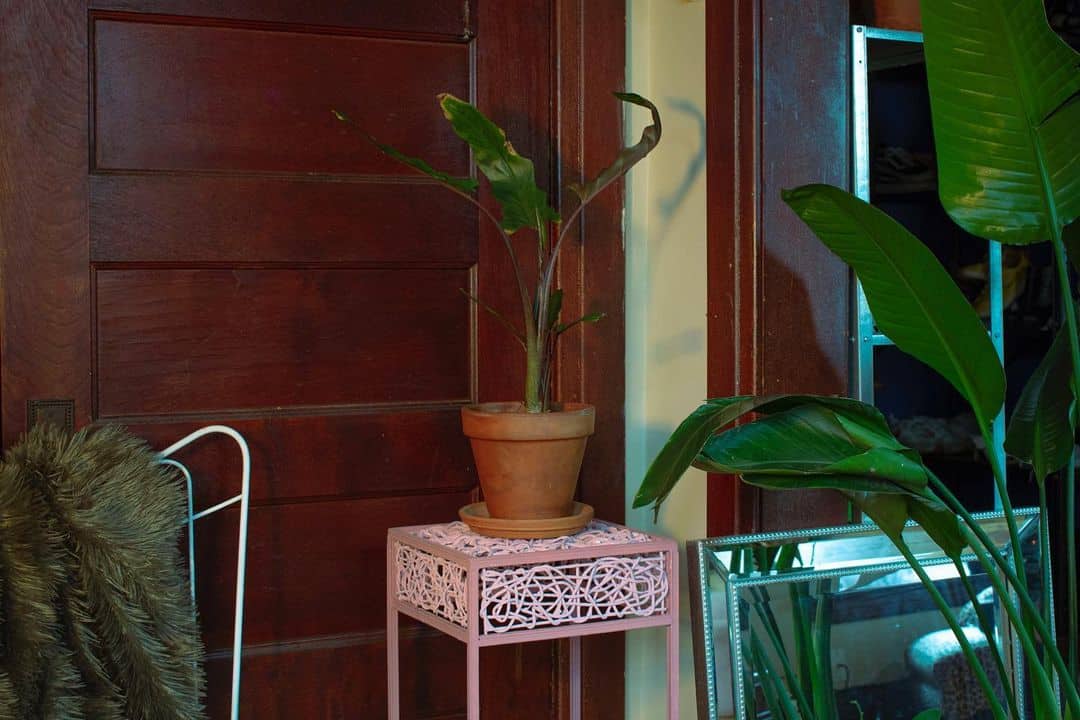The Alocasia purple sword is a low-maintenance houseplant perfect for anyone with a busy schedule. You can put it in your office to brighten it up a bit, or you can keep it on a flower shelf next to your philodendrons and calatheas, it will look great no matter where it goes!
Here are some general specifics about the Alocasia purple sword:
[table id=25 /]Alocasias are also known as elephant ear plants because of their large and beautiful foliage. As soon as you lay your eyes on this gorgeous Alocasia, you will want to get one of your very own!
In this article, you will find everything you need to know about how to give your Alocasia the best possible care, as well as information about its history and mesmerizing looks, so make sure you keep reading.
Here is everything you need to know about the Alocasia purple sword, so let’s get started!
Alocasia Purple Sword Care
Elephant ear plant care is fairly easy and Alocasia isn’t an exception. They just need well-draining soil, water, and sunlight, and they’ll be happy as can be.
However, if you want your alocasia plant to look as good as it possibly can, regular maintenance is key. Light and water won’t be enough, so use all the tips and tricks in this care guide to get the best out of your purple sword or even jewel alocasia if you prefer smaller varieties.
Light
The Alocasia purple sword is a tropical plant, so it thrives best in tropical conditions.
This means it has specific light requirements. Tall trees usually keep these aroids safe from direct sunlight, and you should be sure to mimic this in your home.
The purple sword prefers bright indirect light as this won’t burn its amazing foliage.
You should try to avoid keeping this Alocasia on the north side of your house, as otherwise it won’t receive enough sunlight and start to fade in color.
You can keep your Alocasia a few feet away from a south or west-facing window, but the best place for your Alocasia plant is definitely an east-facing windowsill. This way you can be sure your plant will receive the ideal amount of sunlight.
To provide the best possible plant care, you must provide your alocasia with plenty of indirect sunlight.
Climate And Temperature
The Alocasia purple sword hates the cold and loves warmer climates. Anything between 65 and 75°F (18 and 23°C) is perfect. Anything lower than 60°F (15°C) can cause drooping of foliage and even death.
Keep the thermostat above 60°F (15°C) and this shouldn’t happen.
This plant also likes humidity, so never keep it below the AC. Also, keep your Alocasia away from draughts and avoid temperature swings. It’s important to keep these factors in mind when choosing a home for your purple sword.
Water And Humidity
Photo from: @urbangardenerto
Alocasias are tropical plants, which means they like moisture. However, you should never keep your Alocasia purple sword resting in water as this can lead to fungal infections like root rot.
The best time to water your Alocasia is when you can feel that the topsoil is dry. As soon as the top 2-3 inches (2.5-7.5cm) are dry, you should water your plant thoroughly. It’s important to allow any excess water to drain away before returning the alocasia to its home.
A great idea is to water your Alocasia more frequently, but with smaller amounts. This will keep the soil constantly moist without clogging it.
Another thing you should pay attention to is how you water in different seasons. The Alocasia purple sword actively grows in spring and summer, so it needs more water during these periods. Temperatures are higher in these months and your plant will need more water to prevent dehydration.
In autumn and winter, however, you should cut back on watering as these are the months when your alocasia enters dormancy. During the colder months, there is no fear of drying out so you can even let the soil completely dry between waterings.
It’s important to avoid overwatering your Alocasia purple sword as this could end up being the death of it!
Humidity
Tropical plants like the Alocasia purple sword love high humidity environments. The ideal humidity level for this Alocasia is about 70%. It can tolerate lower levels, but nothing below 45-50%.
I’m sure most homes aren’t this humid, but there are ways to increase humidity levels.
One of my favorite ways to increase humidity is the pebble tray method. You just put some rocks (it doesn’t necessarily need to be pebbles) in a tray and pour water over it. You then put your Alocasia over the tray and you’re done! As the water evaporates, it will raise the humidity around your plant, but not anywhere else in the house.
Another method is misting your Alocasia purple sword, though this is a bit risky. Misting itself is not the issue, but you should make sure that the foliage doesn’t remain wet for long periods because this can lead to fungal diseases.
If you think all this is too much trouble, and don’t mind spending an extra dollar or two, you can always invest in a good humidifier. That way your indoor plant will be safe from fungal infections and you won’t have to worry about maintaining the right humidity level yourself.
Soil And Fertilizer
Photo from: @brushes_n_bloom
The best way to care for an Alocasia lauterbachiana is by reflecting the conditions found in the rainforests of southeastern Asia. This also applies to the type of substrate you should use.
Alocasias love moist soil with good drainage and plenty of nutrients and organic material. You can find aroid potting mix anywhere, but you can also make your own.
Use your favorite soil mix as a base and add perlite or coco coir. This will help with drainage and reduce the risk of root rot. However, you also need to add ingredients that retain moisture, and this is where sphagnum moss (or peat moss) comes in handy.
Moss retains moisture and releases it whenever the plant needs it!
Finally, you will need to improve air circulation to avoid root rot. You can use either orchid bark or horticultural charcoal, or a combination of both. Experiment because you can’t go too far wrong!
Fertilizer
When you’re at the checkout with your aroid potting mix, don’t forget to also grab a bag of water-soluble slow-release fertilizer.
Fertilize your Alocasia twice a month in the spring and summer months, which are its growing season. When the plant enters dormancy, you should stop fertilization.
A piece of advice I wish I got sooner is to water your plants before fertilizing them! If the soil is dry, the chemicals in the fertilizer can cause fertilizer burn and damage the roots.
Repotting Time
The Alocasia purple sword is a fast grower, so you might need to repot it once a year. You can check if the roots are sticking out of the pot to see if your Alocasia needs to be repotted.
The best time for repotting is during the plant’s growing season. This is in spring when roots that are actively growing can have time to adjust to their new container before the plant enters dormancy.
When repotting, experts recommend dividing the roots of the plant. This will make the plant grow faster, but will also reduce its size.
Moreover, when dividing the roots you can use some offset divisions for propagation. The Alocasia purple sword is so beautiful I’m sure you’d love a few more, you could even gift one to a friend!
Here’s a video to help you if you’re repotting this plant for the first time.
How To Propagate The Alocasia Purple Sword
Photo from: @thistleandsagecreative
One thing you need to know before trying to propagate your Alocasia plant is that they grow from rhizomes found under the ground. This means you can propagate them using these offsets.
Sadly, propagating Alocasia purple swords with stem or leaf cuttings is not an option, but never fear because we have a bunch of tips and tricks for propagation that always work!
The 5 Stages of Propagation
Stage 1. The first step is to loosen the soil around the roots. Then remove the plant from its container very carefully and brush off the excess soil.
Stage 2. The second step is to look for offsets. You will notice these baby plants growing from the mother plant. Each of these baby plants will grow into a separate new plant
Stage 3. Next, you should separate the offsets from the mother plant. Do this very carefully with no violent pulling or tugging, as this can cause serious damage to the main plant. Cut them off with a sharp knife or gardening shears, and be sure to wear gloves and sterilize everything so you don’t transfer any bacteria that may kill both the baby plants and mother plant.
Stage 4. Now is the time to plant the offsets into a separate pot. Fill the pot with fresh, aerated, well-draining soil rich in organic content. Also change the mother plant’s soil, and if it needs repotting find it a bigger container.
Stage 5. Finally, you just need to water the plants, put them in a spot where they will receive plenty of bright indirect light, and enjoy the new members of your plant family!
A good thing about offset division is that offsets already have their own root systems, so you won’t have to wait long before your plants are thriving.
And who knows, perhaps they will find a friend in your pothos plant or Alocasia black velvet!
Pruning And Cleaning
The Alocasia purple sword is a fast grower and requires regular maintenance to keep it in check. This includes pruning and cleaning.
If you don’t prune your alocasia plant, it can get really wide and messy. Pruning will give it a healthy and clean look.
There will also be dead or dying leaves around, and it’s best to cut these off so that they don’t taint the beauty of your indoor plant.
You will also need to prune your Alocasia if you notice any irregularities on the leaves, as these can be a sign of disease. Cut off any suspicious looking leaves and throw them away.
Cleaning
Cleaning is very important when it comes to plants with large foliage like the Alocasia purple sword.
Clean the dust with a wet cloth when required, but be sure to dry the leaves afterwards. If you don’t feel like wiping the moisture off the leaves, you can let the plant dry naturally; just be sure not to add additional moisture by spraying or misting.
Brief Story About The Alocasia Purple Sword
Photo from: @miniaturland010818
There are many more interesting facts about Alocasia purple swords, particularly when it comes to the origin and common issues of these plants.
Let’s take a look at their history and a handy care guide.
History
The Alocasia purple sword is a member of the Araceae family ,which originally came from Polynesia. This variegated plan has been called many names throughout history.
It was first known as a member of the Schizocasia genus, and was first described and cataloged as a subtropical plant of Asia by a German botanist named Heinrich Gustav Adolf Engler in 1898.
Next, almost a hundred years later, a botanist called Dan Henry Nicholson categorized it as a member of Xenophya genus in 1968.
Finally, Australian botanist Alistiar Hay renamed this amazing plant in 1990 and described and classified it in the way we know today.
Another thing worth mentioning is that the Alocasia lauterbachiana was also known as Alocasia wavriana, or at least that’s what Garden Chronicles 3 claims.
Foliage And Flowers
The most amazing thing about the Alocasia purple sword is definitely its leaves. It’s not called a purple sword for no reason!
The sharp, sword-like foliage is of an irresistible dark green, which will capture your attention. It has maroon, almost dark purple undersides and veins that make it all the more alluring.
Also, it will fit in just nicely with your other alocasias, especially Alocasia odora variegata , and its beautiful white variegations.
It may surprise you, but the Alocasia purple sword can actually produce flowers. However, compared to the glorious leaves, these green and purple colored flowers are fairly insignificant.
An interesting fact is that this Alocasia can flower all year long if you take care of it properly.
Common Issues
Photo from: @manicplantgirl
The Alocasia purple sword is not impervious to disease, and will get sick every once in a while. Pests will also attack it, but if you’re attentive enough it you should be able to act before it gets too late.
Pests
Pests like spider mites, mealy bugs, and aphids commonly afflict this Alocasia plant. However, you can get rid of them in no time with neem oil or rubbing alcohol. Alcohol can be too harsh, so we only recommend using this in dire need.
You can also try and get rid of these nuisances using soap solutions. However, the best cure is preventing the pests from appearing in the first place, and you can do this by spraying some insecticide on the leaves every now and again.
This can also save you the trouble of wiping dust off the leaves, so give it a go!
Diseases
The Alocasia purple sword is a delicate plant susceptible to root rot.
If you spot root rot in its early stages, there may still be a chance of saving it. One indicator of this fungal infection is dark black or brown spots encircled by a yellowish color. If you notice this, immediately cut off the infected leaves.
You will also need to allow the soil to dry (or better yet, change the old soil and repot the alocasia). Finally, you need to remove any rotting roots that you can see.
How To Spot Problems Early On
To help your Alocasia purple sword, you should try to deal with these problems when they are still in the early stages. You can do this by monitoring its leaves and their color.
If you notice that the leaves of your Alocasia are starting to change color to yellow, it may be an indicator that your plant is overwatered. If you cut back on watering you may still save all the foliage. If the leaves are really yellow and you’ve reached the point of no return, the best thing you can do is cut off the leaves.
Drooping and the appearance of brown spots on the leaves can also be a sign your Alocasia is overwatered.
If you notice that your plant has almost stopped growing, is withering, and the leaves have a grayish hue, it’s a sure sign that your Alocasia is under-watered.
Finally, brown spots on the leaves can also indicate your plant has been burnt by the sun. However, these brown spots aren’t surrounded by yellow circles, which is how you can differentiate between the problems of underwatering and too much direct sunlight.
Q & A Corner
In this final section, you will find the answers to the most frequently asked questions about the Alocasia purple sword.
Is the purple sword Alocasia rare?
The Alocasia purple sword is not as rare as some people claim. Its native habitat may be limited to South East Asia (mainly Borneo), but if you go online you can find many stores that sell this exotic plant.
And it’s quite affordable!
What is the difference between a purple sword and a sword plant?
The Purple sword belongs to the genus Alocasia and is also called Alocasia lauterbachiana. It belongs to the Araceae family.
The Sword plant, on the other hand, belongs to the genus Echinodorus and its scientific name is Echinodorus grisebachii or Echinodorus amazonicus (Amazon sword plant). It belongs to the family of Alismataceae.
The Sword plant is native to the western hemisphere, whereas the purple sword can be found in Polynesia and New Guinea.
The sword plant is also an aquatic plant, which means it is used in ponds, aquariums, and other artificial aquatic habitats.
However, the Purple sword plant is a tropical plant that cannot survive being submerged in water.
What does Alocasia purple sword taste like?
The Alocasia purple sword has a sour taste because of the oxalate crystals found in its leaves.
However, these crystals are poisonous and can cause death to your pets and lead to vomiting, diarrhea, skin irritation and swelling, and burning of the mouth and airways in humans.
Summary
After all that, we can finally conclude that the Alocasia purple sword is a jewel among houseplants and will go very nicely with any plant of the Anthurium genus.
It is very easy to maintain, and propagation is almost always successful (and fast).
I’m sure this plant would be a great addition to your indoor garden.
Until next time!
Like this post? Share or pin it for later!

